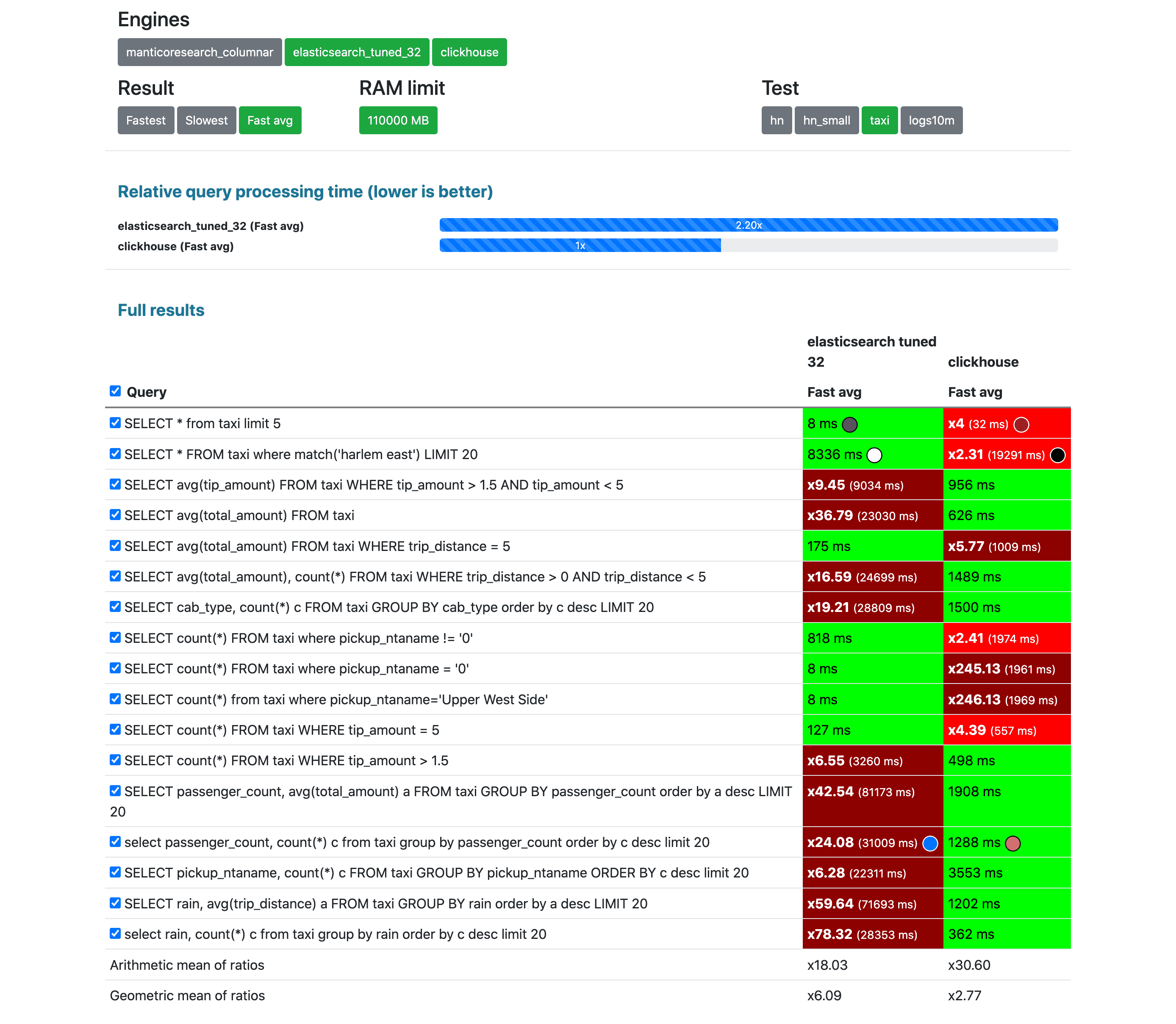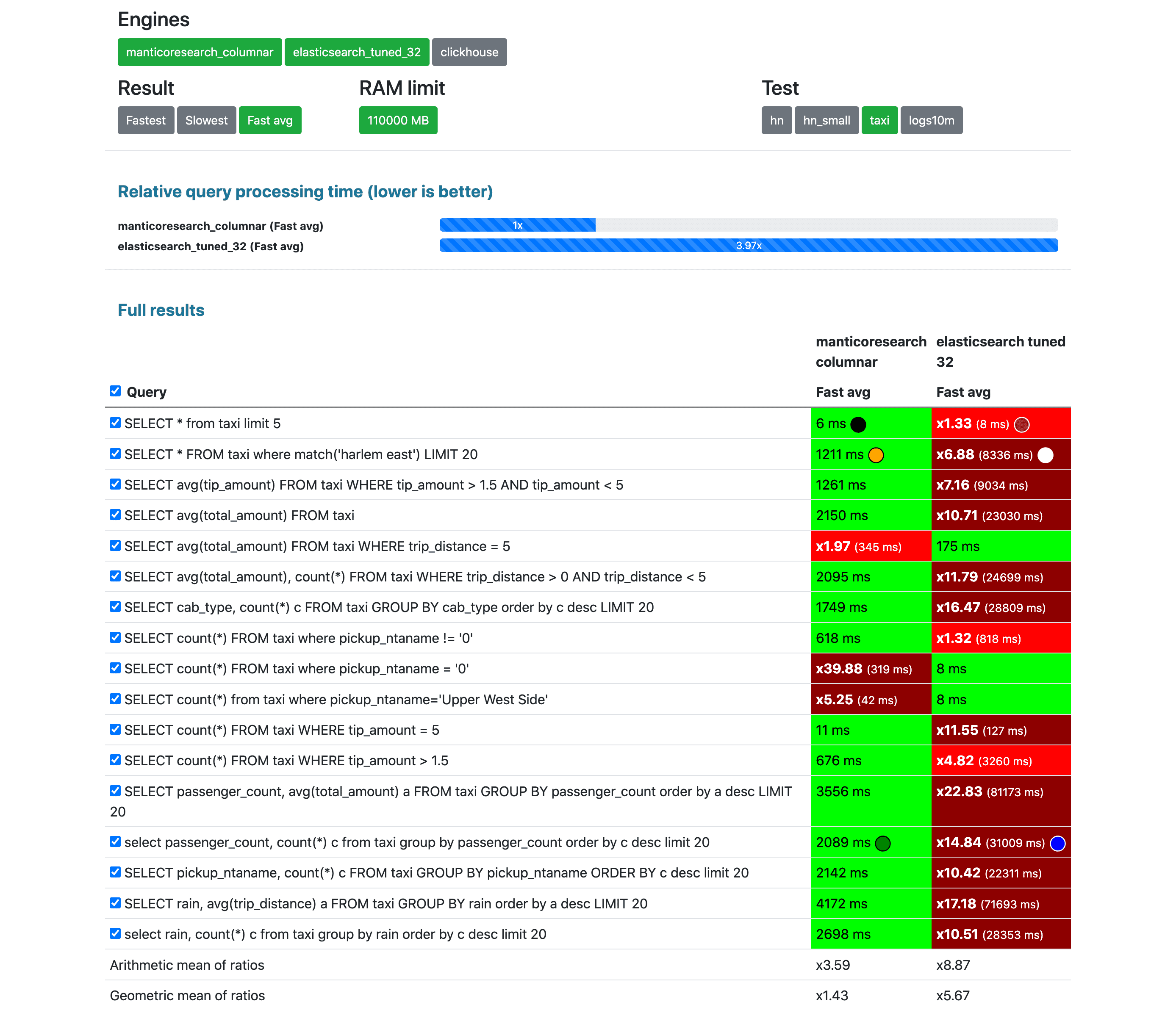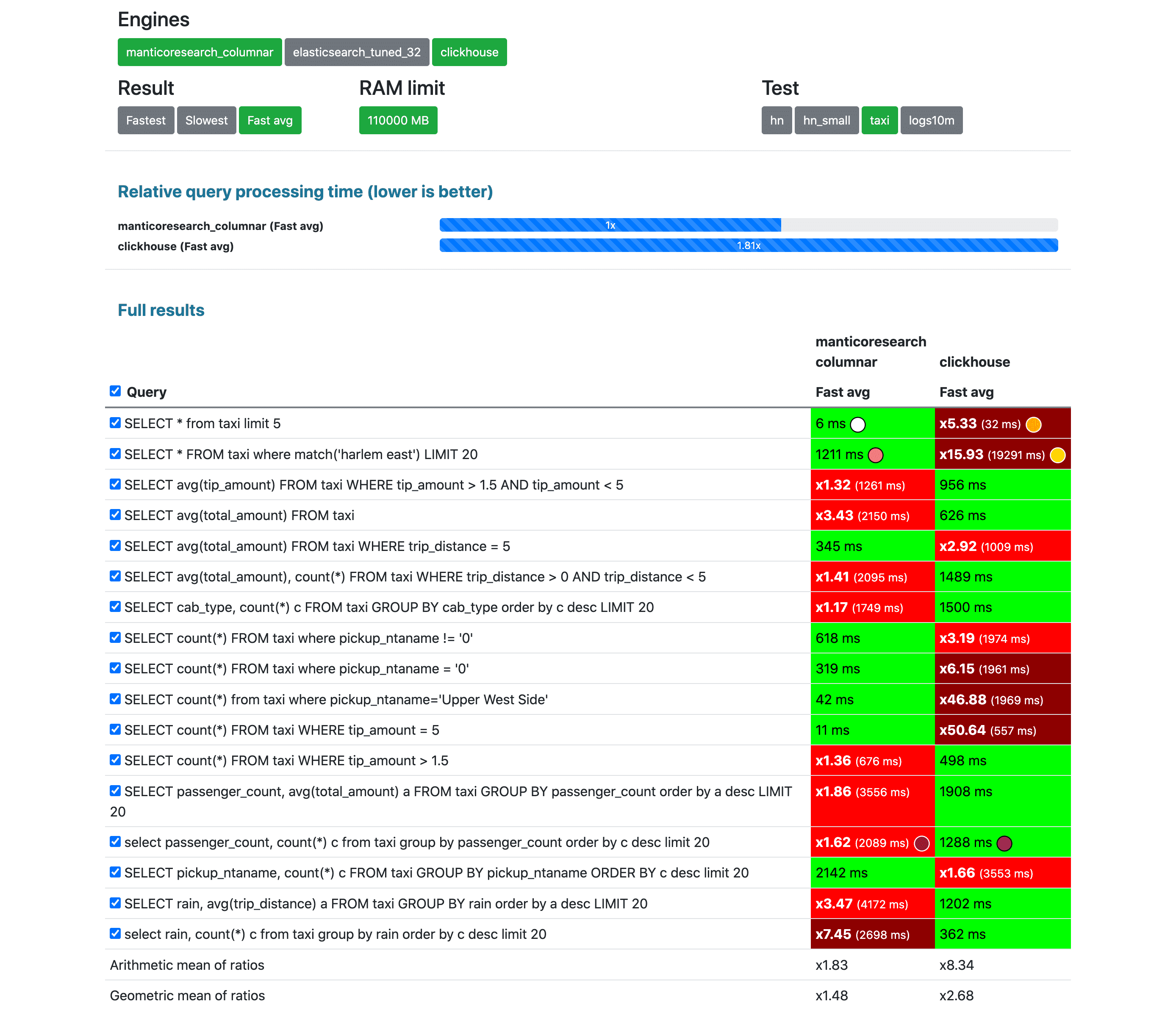1.7B NYC Taxi rides test: Clickhouse vs Elasticsearch vs Manticore Search

Intro
NYC taxi rides is probably the most commonly used benchmark in the area of data analytics.
It started with Todd W. Schneider deciding to prepare the collection first in 2015 to analyze 1.1 billion NYC Taxi and Uber Trips. Then Mark Litwintschik continued by testing lots of databases and search engines using the data collection.
Now we at https://db-benchmarks.com/:
- have dockerized preparation of the data collection to make it easier to use
- made it available as a part of the most transparent and open source database benchmarks suite .
Data collection
The data collection constitutes 1.7B taxi and for-hire vehicle (Uber, Lyft, etc.) trips originating in New York City since 2009. Most of the raw data comes from the NYC Taxi & Limousine Commission.
The data collection record includes a lot of different attributes of a taxi ride:
- pickup date and time
- coordinates of pickup and dropoff
- pickup and dropoff location names
- fee and tip amount
- wind speed, snow depth
- and many other fields
It can be used mostly for testing analytical queries, but it also includes a couple of full-text fields that can be used to test free text capabilities of databases.
The whole list of fields and their data types is:
|
|
Databases
So far we have made this test available for 3 databases:
- Clickhouse - a powerful OLAP database,
- Elasticsearch - general purpose “search and analytics engine”,
- Manticore Search - “database for search”, Elasticsearch alternative.
In this test we make as little changes to database default settings as possible to not give either of them an unfair advantage. Testing at max tuning is no less important, but it’s a subject for another benchmark. Here we want to understand what latency a regular non-experienced user can get after just installing a database and running it with its default settings. But to make it fair to compare one with another we still had to change a few settings:
- Clickhouse: no tuning
, just
CREATE TABLE ... ENGINE = MergeTree() ORDER BY idand standard clickhouse-server docker image. - Elasticsearch: here to make it fair to compare with the other databases we had to help Elasticsearch
by:
- letting it make 32 shards: (
"number_of_shards": 32), otherwise it couldn’t utilize the CPU which has 32 cores on the server, since as said in Elasticsearch official guide “Each shard runs the search on a single CPU thread”. bootstrap.memory_lock=truesince as said on https://www.elastic.co/guide/en/elasticsearch/reference/current/docker.html#_disable_swapping it needs to be done for performance.- the docker image is standard
- letting it make 32 shards: (
- Manticore Search is also used in a form of their official docker image + the columnar library they provide
:
- as well as with Elasticsearch we also use 32 shards in a form of 32 plain indexes
- and we use Manticore columnar storage since comparing Manticore’s default row-wise storage vs Clickhouse’s and Elasticsearch’s columnar storages would be not fair on such a large data collection.
- we added
secondary_indexes = 1to the config which enables secondary indexes while filtering (when loading data that’s built anyway). Since Elasticsearch uses secondary indexes by default and it’s fairly easy to enable the same in Manticore it makes sense to do it. Unfortunately in Clickhouse user would have to make quite an effort to do the same, hence it’s not done, since it would then be considered a heavy tuning which would then require further tuning of the other databases which would make things too complicated and unfair.
About caches
We’ve also configured the databases to not use any internal caches. Why this is important:
- In this benchmark, we conduct an accurate latency measurement to find out what response time users can expect if they run one of the tested queries at a random moment, not after running the same query many times consequently.
- Any cache is a shortcut to low latency. As written in Wikipedia
“cache stores data so that future requests for that data can be served faster”. But caches are different, they can be divided into 2 main groups:
-
👌 those that just cache raw data stored on disk. For example many databases use
mmap()to map the data stored on disk to memory, access it easily and let the operating system take care about the rest (reading it from disk when there’s free memory, removing it from memory when it’s needed for something more important etc). This is ok in terms of performance testing, because we let each database leverage the benefit of using the OS page cache (or its internal similar cache that just reads data from disk) That’s exactly what we do in this benchmark. -
❗ those that are used to save results of previous calculations. And it’s fine in many cases, but in terms of this benchmark letting database enable such a cache is a bad idea, because:
- it breaks proper measuring: instead of measuring calculation time you start measuring how long it takes to find a value by a key in memory. It’s not something we want to do in this test (but it’s interesting in general and we’ll perhaps do it in the future and publish some article “Benchmark of caches”).
- even if they save not a full result of a particular query, but results of its sub-calculations it’s not good, because it breaks the idea of the test - “what response time users can expect if they run one of the tested queries at a random moment”.
- some databases have such a cache (it’s usually called “query cache”), others don’t so if we don’t disable database internal caches we’ll give an unfair advantage to those having that.
So we do everything to make sure none of the database does this kind of caching.
-
What exactly we do to achieve that:
- Clickhouse:
SYSTEM DROP MARK CACHE,SYSTEM DROP UNCOMPRESSED CACHE,SYSTEM DROP COMPILED EXPRESSION CACHEbefore testing each new query (not each attempt of the same query).
- Elasticsearch:
"index.queries.cache.enabled": falsein its configuration/_cache/clear?request=true&query=true&fielddata=truebefore testing each new query (not each attempt of the same query).
- Manticore Search (in configuration file):
qcache_max_bytes = 0docstore_cache_size = 0
- Operating system:
- we do
echo 3 > /proc/sys/vm/drop_caches; syncbefore each NEW query (NOT each attempt). I.e. for each new query we:- stop database
- drop OS cache
- start it back
- make the very first cold query and measure its time
- and make tens more attempts (up to 100 or until the coefficient of variation is low enough to consider the test results high quality)
- we do
Queries
The queries are mostly analytical queries that do filtering, sorting and grouping. We’ve also included one full-text query:
|
|
Results
You can find all the results on the results page by selecting “Test: taxi”.
Remember that the only high quality metric is “Fast avg” since it guarantees low coefficient of variation and high queries count conducted for each query. The other 2 (“Fastest” and “Slowest”) are provided with no guarantee since:
- Slowest - is a single attempt result, in most cases the very first coldest query. Even though we purge OS cache before each cold query it can’t be considered stable. So it can be used for informational purposes only (even though many benchmark authors publish such results without any disclaimer).
- Fastest - just the very fastest result, it should be in most cases similar to the “Fast avg” metric, but can be more volatile from run to run.
Remember the tests including the results are 100% transparent as well as everything in this project, so:
- you can use the test framework to learn how they were made
- and find raw test results in the results directory.
Unlike other less transparent and less objective benchmarks we are not making any conclusions, we are just leaving screenshots of the results here:
3 competitors at once

Clickhouse vs Elasticsearch

Manticore Search vs Elasticsearch

Manticore Search vs Clickhouse

Disclaimer
The author of this test and the test framework is a member of Manticore Search core team and the test was initially made to compare Manticore Search with Elasticsearch, but as shown above and can be verified in the open source code and by running the same test yourself Manticore Search wasn’t given any unfair advantage, so the test can be considered unprejudiced. However, if something is missing or wrong (i.e. non-objective) in the test feel free to make a pull request or an issue on Github . Your take is appreciated! Thank you for spending your time reading this!
